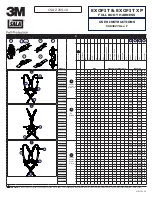
3
www.mastercool.com
SAFETY INFORMATION! READ CAREFULLY BEFORE USING RECOVERY SYSTEM!
CAUTION! This equipment should only be operated by certified personnel.
SAFETY SUMMARY
The following safety information is provided as guidelines to help you operate your new system under the safest possible
conditions. Any equipment that uses chemicals can be potentially dangerous to use when safety or safe handling instructions
are not followed. The following safety instructions are to provide the user with the information necessary for safe use and
operation. Please read and retain these instructions for the continued safe use of your service system.
SAFETY INFORMATION
Customers respect the tools with which they work. They know that the tools represent years of constantly improved designs
and developments. The customer also knows that tools are dangerous if misused or abused. To reduce risk of discomfort,
illness, or even death, read, understand, and follow the following safety instructions. In addition, make certain that anyone
using this equipment understands and follows these safety instructions as well.
READ ALL SAFETY INFORMATION CAREFULLY before attempting to install, operate, or service this equipment. Failure to
comply with these instructions could result in personal injury and/or property damage.
RETAIN THE FOLLOWING SAFETY INFORMATION FOR FUTURE REFERENCE.
Published standards on safety are available and are listed at the end of this section under ADDITIONAL SAFETY INFORMATION.
The National Electrical Code, Occupational Safety and Health Act regulations, local industrial codes and local inspection
requirements also provide a basis for equipment installation, use, and service.
The following safety alert symbols identify important safety messages in this manual. When you see one of the symbols
shown here, be alert to the possibility of personal injury and carefully read the message that follows.
ELECTRICAL SHOCK HAZARDS
• Make sure system is electrically connected to a properly grounded power source.
• To reduce the risk of electric shock, unplug the air service center from the outlet before attempting any maintenance or
cleaning. Turning off controls will not reduce this risk.
• Do not operate the machine with a damaged cord or plug - replace immediately. To reduce the risk of damage to
electric plug and cord, disconnect recovery machine by pulling on the plug rather than the cord.
An extension cord should not be used unless absolutely necessary. Use of an improper extension cord could result in a risk of
fire and electric shock. If extension cord must be used, make sure:
a. That pins on plug of extension cord are the same number, size, and shape as those on machine recovery plug.
b. That extension cord is properly wired and in good electrical condition; and
c. That the wire size is large enough for the length of cord as specified below:
Length of cord in feet:
25
50
100
150
AWG size of cord:
16
12
10
8
MOTION HAZARDS
• Engine parts that are in motion and unexpected movement of a vehicle can injure or kill. When working near moving
engine parts, wear snug fit clothing and keep hands and fingers away from moving parts. Keep hoses and tools clear of
moving parts. Always stay clear of moving engine parts. Hoses and tools can be thrown through the air if not kept clear
of moving engine parts.
• The unexpected movement of a vehicle can injure or kill. When working on vehicles always set the parking brake or
block the wheels.
FUME HAZARDS
• FUMES, GASES, AND VAPORS CAN CAUSE DISCOMFORT, ILLNESS, AND DEATH! To reduce the risk of discomfort, illness,
or death, read, understand, and follow the following safety instructions. In addition, make certain that anyone that uses
the equipment understands and follows these safety instructions as well.
• Avoid breathing A/C refrigerant and lubricant vapor mist. Exposure may irritate eyes, nose, and throat.
• Always perform vehicle service in a properly ventilated area. Never run an engine without proper ventilation for its
exhaust.
• Stop the recycling process if you develop momentary eye, nose, or throat irritation as this indicates inadequate
ventilation. Stop work and take necessary steps to improve ventilation in the work area.
HEAT/FREEZING HAZARDS
• When under pressure, refrigerants become liquid. When accidentally released from the liquid state they evaporate and
become gaseous. As they evaporate, they can freeze tissue very rapidly. When these gases are breathed in, the lungs
can be seriously damaged. If sufficient quantities are taken into the lungs, death can result. If you believe you have
exposed your lungs to released refrigerant, seek immediate medical assistance.
English




































